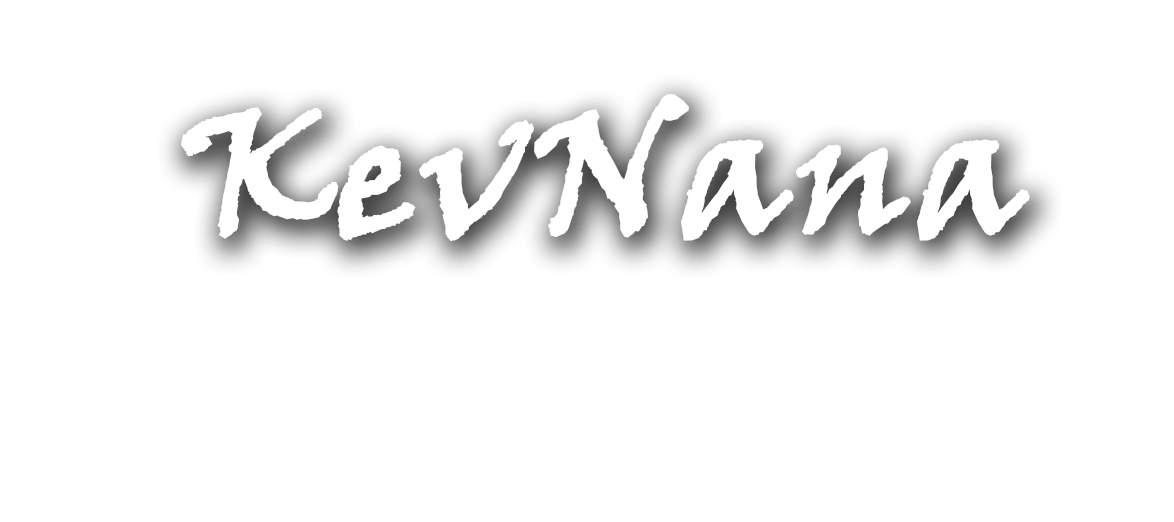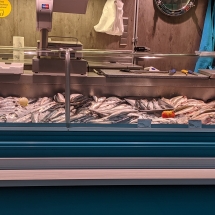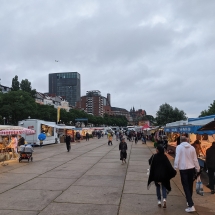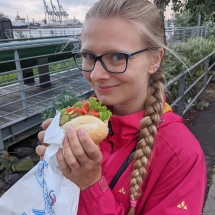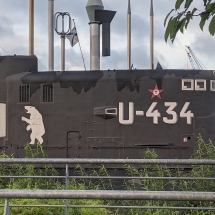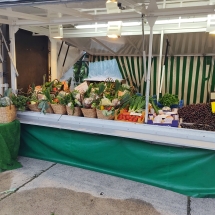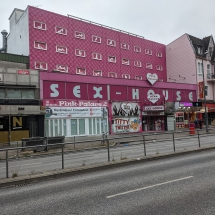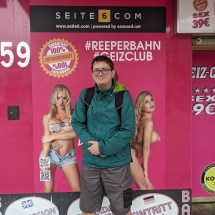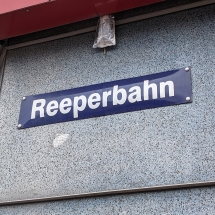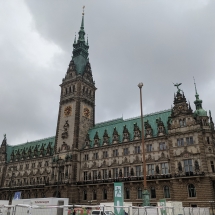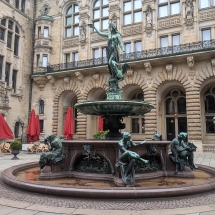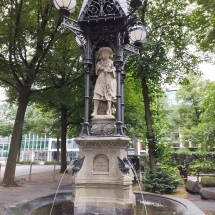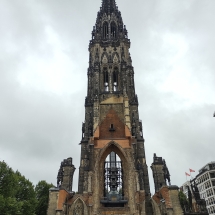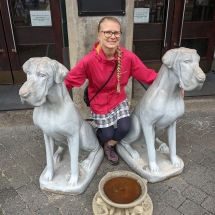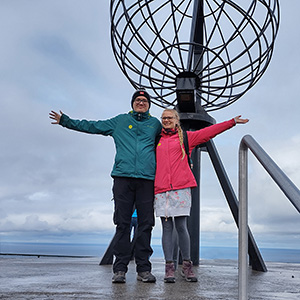
Scandinavia (2021): From Thuringia to the North Cape and back
Inhalt/Content
Like so many others, the corona pandemic has thwarted our travel plans for 2020. We were in South Africa shortly before the outbreak of the pandemic and even a short vacation on the Polish Baltic Sea was possible in the summer, but we had accumulated a few vacation days that we now, freshly vaccinated, finally wanted to enjoy by traveling for a whole month. Of course, the world was far from what we were used to before 2020. For sure, this was also reflected in our way of traveling and, above all, in our destination. The Scandinavian countries have also taken some special paths, but all in all they naturally benefited from their high standard of living and good medical care. Also, we didn’t want to squeeze into a cramped plane with lots of other people, so we decided to rent a camper instead. And this is where the story begins, even though we hadn’t even left yet. No need to mention that we weren’t the only ones who came up with the idea of renting a camper, which was reflected not only in the strong demand, but above all in the price. Instead of renting a proper campervan, we instead opted for a slightly modified Opel Combo in a fabulous shade of yellow. A second battery was installed up front so that we could transport our groceries in an electric cooler and a roof box not only provided additional storage space, but also contained two gas-powered hotplates. The loading area at the back should serve as a place to sleep, laid out with our inflatable camping mats. Except for a bathroom we had everything we needed with us. Full of energy we set off on July 31st on a 8000 km long and one month journey from Thuringia to the North Cape and back…
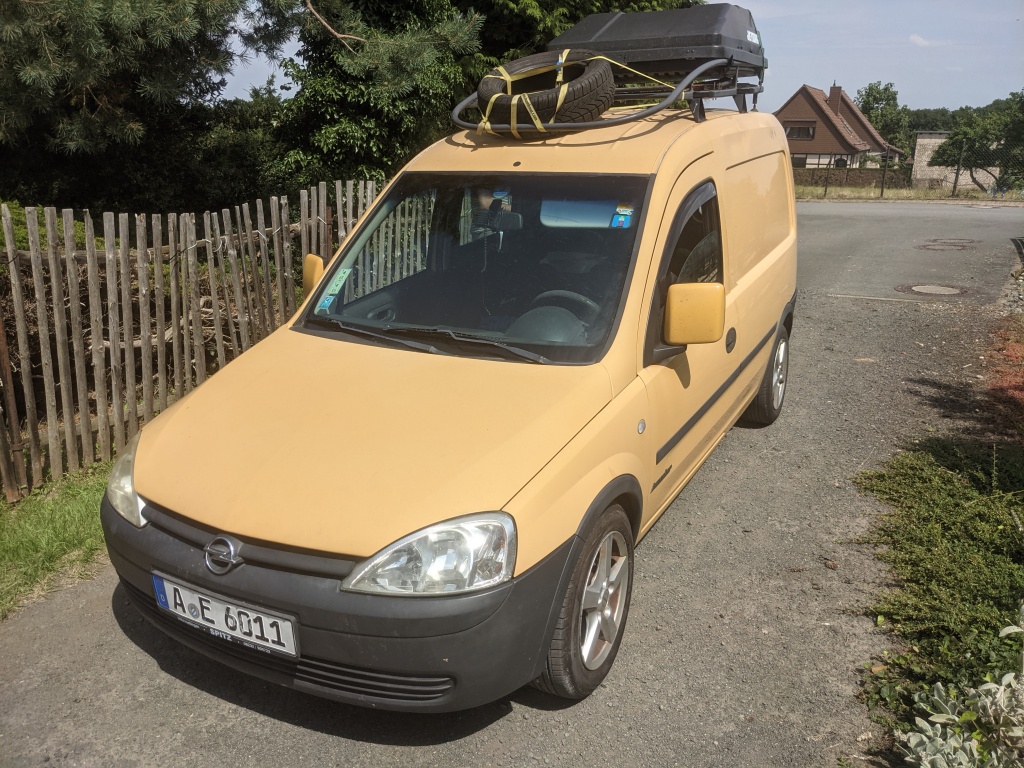
Hamburg
Our first stop was in Germany, namely Hamburg. Since the city is quite popular in the gaming world and Kevin has always wanted to go there, we spent two nights there. Optimistic and full of energy, we set off from Weimar at 8 a.m. in the morning. Kevin’s sprained ankle had recovered enough by now for him to be able to do the first half of the ride. As perfect as it started, the good mood vanished just as quickly. One traffic jam followed the next and the numbers on our smartphone navigation system, which were supposed to show us how long we still needed to get to our destination, were bright red and got bigger and bigger. Some time after the driver change, the app suggested me to avoid part of the next traffic jam using an alternative route and in desperation I immediately pressed OK, which turned out to be a mistake. The next moment we drove across a NATO military training area. Not a soul was to be seen far and wide, so we drove through a city full of empty dummy buildings where the soldiers were supposed to be doing various exercises. The atmosphere was more like in a post-apocalyptic horror film and nobody can talk about saving time, since only walking speed was allowed, whereby not a km/h too much would be possible with all the much too big bumps that adorned the streets. For a brief moment we were relieved when we were finally able to drive back onto the freeway, until of course we were stuck in the next traffic jam.
After a proud 8(!) hour drive, we finally reached our destination, an amazingly centrally located campsite in Hamburg’s Stellingen district. The place itself consisted only of a few gravel pitches for campers, a reception and a manageable number of sanitary facilities right next door. Even when we arrived late, some force majeure was probably not kind to us, because it was raining cats and dogs, but after such a terrible journey we only took note of it with resignation. As soon as the rain cleared a bit, we headed out to have dinner. It struck us that we left something very essential in Weimar: umbrellas. Luckily we passed a textile discounter, which was still open for 2 minutes. Enough time to take the next two best umbrellas and run to the checkout with them. Not far away we decided to eat in a branch of a restaurant chain, which I knew from Dortmund. This is also where our vaccination certificates were checked for the very first time, since Hamburg already had the 3G rule for gastronomy at the time. Kevin ordered a lumberjack steak and I had a baked potato with spinach. Both dishes were really tasty. Finally a ray of hope after almost everything had gone wrong that day. While we happily shoveled in our dinner, a small spectacle played out before our eyes. Some people who looked like zoo workers tried in vain to capture a magpie that looked weak. The employee at an adjacent kebab shop came to their aid. But the magpie was always one step ahead of the people. So she jumped into dense bushes from which you just couldn’t get her out, or she jumped under parked cars so that nobody could get to her. Ultimately, the magpie won when it suddenly took to the air and flew away.
What followed was something we had admittedly feared: the first night in the car. After we stowed everything that we didn’t need upstairs and everything that should somehow remain within reach on the front seats, we spread out our camping mats. Admittedly, it didn’t even look that tired. We hid our shoes under the car as it had started to rain heavily again and finally we rolled into our sleeping bags and slept much better than expected.
Fish market and Reeperbahn
Even if the sleep was more restful than expected, it didn’t last long, because our first item on the agenda for the day was a visit to the Hamburg fish market, which, as is well known, opens at 5:00 a.m. in the morning. Since it is not always easy to get up early in the morning, we were of course late, which meant that we finally had to run to the bus stop. Luckily we still got the bus. The bus driver, who was really very friendly, saw right through us and realized that we probably want to go to the fish market. Since we didn’t quite know where to get off, he let us know when we were at the relevant stop on the notorious Reeperbahn and even came to the back of the bus to explain how we had to walk from there . Despite some Corona requirements, the fish market was really cool. There was of course a lot of fresh fish, but also souvenirs, fruit and vegetable stalls. I have to admit that I was a bit excited when I saw how whole baskets full of fruit as well as vegetables were sold there. We stocked up on initial souvenirs (fridge magnets for my parents and a pillow with a seal on it, which Yuri hates for some reason so we have to hide it from him) before moving on to the main point of our visit here at the fish market, breakfast . Kevin grabbed a lot and bought 2 baguettes, 10 quark balls and a really delicious fruit cup. I, on the other hand, opted for the classic: a fish sandwich. There was also a small bowl of blackberries, the bottom ones of which were unfortunately already moldy, and a really good coffee. Due to the Corona requirements, we left the Fischmarkt grounds to eat. We ended up right in front of another attraction: the U-boat Museum. Kevin told me how he was in a submarine when he was a kid and that was really interesting. We ultimately decided later, when the museum opened, to come back here and pay a visit to the whole thing.
Where we’ve been there before, we wanted to at least walk across the Reeperbahn. Actually, the plan was to come here on the evening of our arrival to see the party mile in all its glory, but due to the exertion of the drive we were simply too tired for that. So here we were, strolling through on a Saturday morning while clean-up crews swept broken glass bottles and other junk off the street. There were hardly any party guests left, instead homeless people gathered in some places, of whom Hamburg unfortunately has far too many. At the end of the Reeperbahn we went down to the subway station and from there to the town hall. We only stayed here for a short time, because the entire square in front of the town hall was closed due to an open-air theater. So we could only take a few photos from the side. Shortly thereafter we also discovered the ruins of the Nikolaikirche. It would have been nice to go up the tower here, but unfortunately it was still closed. We killed the next few hours walking through the Speicherstadt and exploring the area a bit before we went to our next item for the day: Dialogue in the dark.
Dialogue in the Dark
We had already booked a one-hour tour of a special kind in advance. Dialogue in the Dark is a guided tour through various everyday situations, such as a park or a market square. The special thing about it is that this happens in complete darkness. You are handed a white cane and the person leading the tour is blind himself so you are immersed in their world. Arrived on site, we had to lock everything that we didn’t need or that could shine in lockers. We should also lock away our glasses with the snide remark that we don’t need them for dialogue in the dark anyway. We should only pocket a few coins in order to be able to get something in a dark bar at the end. Smaller exhibitions on the topic of diversity could already be admired in the anteroom, which also served as a waiting room.
Our group consisted of 8 people plus the tour guide: 4 teenage girls, a middle aged couple and Kevin and myself. First, a lady at the entrance to the parkour explained the process and how we had to use the white canes. Then our tour guide, whose name I unfortunately forgot, picked us up. It went down a small ramp into total darkness. That was too much for the middle-aged lady in our group. She announced that she wanted out and turned back on the spot. Later she came back with the lady who had given us the white canes and so she managed the tour after all. Admittedly, it took a lot of getting used to seeing absolutely nothing around you. But the tour guide handled it really well. He briefly introduced himself and then asked each of us to do the same. Surprisingly, he remembered all the names straight away and always addressed us correctly. He walked in front of us trying to keep speaking so we could follow his voice. At certain passages he continued to speak and guided us by giving us instructions to pass him on the left or right. So we first went to a small park over gravel paths and two small bridges. As soon as you got used to the darkness, you also started to get a little braver, which you could then live out in the next station, a house. There you walked around with a white cane and groped around and tried to guess what was where. The tour guide would come up to you every now and then and let you guess where you might be standing in front of it. Out of the house we went over cobblestones across a small market square and across a street. It is amazing how difficult it is to cross a simple street, even though the traffic lights were already making noises suitable for the blind. However, these were drowned out by general noise, such as the hum of the cars, and so in the end everyone ran over red. Kevin said he even found the traffic light and wanted to wait, but when everyone ran across the street, of course, peer pressure won out.
Finally we went to the said dark bar. It wasn’t that easy to find the right coins. We ordered at the counter, where the bartender himself was of course blind, and were then shown to our seats individually by our tour guide. Once we were all seated at the table, he explained that he would now be answering questions and that there were no wrong questions. The teenagers started right away with seemingly banal questions, such as how to put on make-up when you’re blind. Of course, I asked about the sport and found out that you can actually go jogging blindly by holding or even tying yourself to a sighted person. Our tour guide also told us that he wasn’t born blind at all, but only went blind in his early 20s. We also learned that the majority of all blind people cannot read Braille at all, since many only become blind in old age and it is then too difficult to learn to read again. What really fascinated me was how well the tour guide dealt with his handicap. On the one hand he was incredibly open about it and liked to make one or the other joke and on the other hand it was really impressive how well he seemed to be able to arrange his life and everyday life.
After the conversation, we went into a room with slightly dimmed lights, where our eyes could slowly get used to the brightness again. This is where we really saw our tour guide for the first time, after he had guided us through the parkour with his voice for the last hour. That was kind of interesting, because you naturally imagine what people look like based on their voice, and I was actually totally wrong with my assessment. Among other things, he looked much younger than I would have thought. Finally we said goodbye, handed in our white canes and went back into the bright world where we could see something again. The whole tour was terribly interesting and I recommend anyone who is in Hamburg to try their hand at dialogue in the dark. Later we found out that there should probably still be one in Frankfurt. There is also the dialogue in silence, where you immerse yourself in the world of the deaf. I would definitely like to try that too.
Elbphilharmonie and Submarine Museum
After the dialogue in the dark, we first went to a French restaurant, where we strengthened ourselves with delicious galletes (Kevin with ham, egg and cheese and I with spinach, blue cheese, walnuts and salad). Unfortunately, the weather left a lot to be desired and so we had to take shelter again and again because the rain, despite the umbrellas, was just too heavy. So, with a few interruptions due to the weather, we made our way to the Elbphilharmonie. Although the Elbphilharmonie had a rather scandalous construction phase, which earned it many comparisons with Berlin Airport BER, it is now considered an important feature in Hamburg. Admittedly, the building looks really impressive. On site, we also learned that the visit including the visitor terrace was free of charge, so that shortly afterwards we found ourselves on the long escalator up into the building. This escalator alone was quite impressive, like a futuristic tunnel from a science fiction film. From the visitor terrace you could walk around the building from the outside and had a great view over the harbor and part of the city. There was also a souvenir shop inside, which we didn’t visit, because due to the corona regulations, only a limited number of people were allowed in and the queue was far too long, only to then examine a few overpriced souvenirs that we didn’t have anyway want to buy.
The last highlight of the day, as spontaneously decided in the morning, should be the submarine museum. In front of the Elbphilharmonie, we noticed that Hamburg’s local public transport not only had buses and the subway, but that there were also ferries that took you from A to B with the normal local transport tickets. Since we didn’t feel like a long boat tour in this weather, we decided to take the next ferry instead as a short trip, as it conveniently stopped near the museum. So we were still able to take a look at the harbor area from the water. Arrived at the port, I briefly visited the Elbe tunnel, where I was the only person who took both down and up the stairs, so I didn’t have to queue for the full elevator.
The submarine museum consisted of a museum shop, where the tickets were sold directly, and an old submarine that you walk through. There were guided tours, but we didn’t want to wait for the next tour and instead decided to explore the submarine on our own, which in the end was the right decision, as it is well known that such a submarine is very cramped and so we glad we didn’t have to go through it with a group of people. At the entrance, we noticed a conceptual error: the visit was structured as a tour, where you board the submarine at the back and come out at the front. Although the beginning and end were not identical, there was an umbrella stand at the entrance, in which umbrellas were already lying. Since we noticed the mistake, we simply took our umbrellas with us. At the exit, however, we met a family who had not done so and were now wondering how to get their umbrellas. The museum itself was very interesting. Personally, I have never been in a submarine and found it incredible how little square meters people can live in (even though Kevin and I not only lived in a 12 square meter room for half a year and have now spent a month in an Opel, so to speak combo lived).
The visit to the U-Boot Museum ended our sightseeing day in Hamburg and so we returned to the campsite, had dinner, showered and watched a film together while still lying in our quasi-bed before our second night in the camper started.

